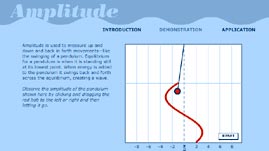Teachers' Domain - Digital Media for the Classroom and Professional Development
User: Preview

Source: The ASPIRE Lab, University of Utah
In this interactive activity adapted from the University of Utah's ASPIRE Lab, learn about amplitude. In the case of an object moving back and forth, such as a pendulum, the amplitude of the motion is the distance from equilibrium to maximum displacement. Adjust the amplitude of a swinging pendulum and see how the resulting waveform changes. Next, adjust the volume control to hear sounds of different amplitudes and see the corresponding waveforms.
Waves are oscillating disturbances that propagate through space. For example, a vibrating object produces sound waves by disturbing the particles in a medium (such as air). As each wave passes through the medium, it creates alternating regions of high and low density. Scientists have agreed to visually represent all waves as having a sinusoidal shape—the familiar S-shape. For example, if a vibrating tuning fork with a pencil attached to it were dragged across a surface, it would draw a sinusoid. The points of maximum displacement in the positive or negative direction are known as the "crests" and "troughs" of a wave.
The amplitude of a wave—the distance from equilibrium to a crest or to a trough—is the measure of the maximum disturbance. In addition, the amplitude is related to the amount of energy carried by the wave. For example, imagine a boat floating on the surface of the ocean. As water waves pass under the boat, the boat bobs up and down; it goes up on the crest of a wave and down on a trough. If the energy of the water waves passing under the boat increases, the amplitude also increases such that the boat experiences a greater displacement and bobs up and down in bigger motions.
The amplitude of a wave is proportional to its energy but does not affect its wavelength, frequency, or speed. For example, if you play a note on a piano, it produces a sound wave at a particular frequency. If you alter how much energy you put into hitting the note, you change only the amplitude of the sound wave. The tone produced by that note remains the same, but a larger amplitude wave creates a louder sound. Conversely, a smaller amplitude wave creates a softer sound.
Interestingly, when two waves meet, the resulting disturbance is a combination of the two waves. In other words, when two waves collide, they create a disturbance whose amplitude is equal to the sum of the amplitudes of the two individual waves. In some cases, the waves add up to create a larger amplitude disturbance. However, in other cases, the waves cancel each other out (such as when a crest collides with a trough) and the resulting disturbance is smaller then the amplitude of either wave.
 Loading Standards
Loading Standards Teachers' Domain is proud to be a Pathways portal to the National Science Digital Library.
Teachers' Domain is proud to be a Pathways portal to the National Science Digital Library.
